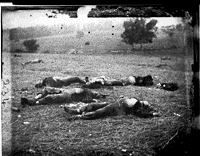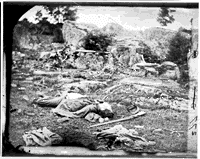November 16, 2001
Civil War
Tidbits and Trivia Page
![]()
Photographers often want to communicate a thought or emotion with their work. Although the camera lens views the world impartially, the photographer constantly judges, deciding what to photograph and how to photograph it -- focusing on creating a strong image that will communicate the desired message. The words that accompany a photograph may also influence the way we "read" the picture. The following photographs are from the collection of Alexander Gardner's "1865 Gardner's Photographic Sketch Book of the War." The analysis is based upon the pioneering work of the historian William Frassanito in his book Gettysburg: A Journey in Time, published in 1975. So far, this has to be the most fascinating tidbit I have dug up in my Civil War research. See Gardner's poetic captions, his biography and Frassanito's "clues"at the end of this page.

|

|

|
A Harvest of Death... Alexander Gardner describes these soldiers as dishonored Confederate troops who paid for their treason with their lives, dying a lonely battlefield death, buried by strangers in graves far from home. |
| Field where General Reynolds Fell...Alexander Gardner's melancoly description of these Union troops was that they were...calm and peaceful in death, so tranquil that they seem about to wake and rise. | 
|
To confirm these identifications,
researchers may wish to compare the
placement of hands and feet. Other
features of the men's uniforms permitted
Frassanito to identify them as Union.
Topographic clues convinced him that the
photographs were made in open fields
near the Rose farm and close to the
Emmitsburg Road.
Under General Dan Sickles, the Union 3d Corps suffered heavy losses around Emmitsburg Road. General John Reynolds, commander of the 1st Corps and mentioned in Gardner's title, fell at a different location.

|
The Home of a Rebel Sharpshooter... Alexander Gardner identifies this man as a Confederate soldier who built up between two huge rocks, a stone wall, from the crevices of which he had directed his shots. |
| A Sharpshooter's Last Sleep...Alexander Gardner describes this Conferate soldier in Devil's Den ...as a sharpshooter lying as he fell when struck by a bullet. | 
|
Frassanito argues that the original location of the body was the southern slope of Devil's Den, suggesting that the soldier was probably an infantryman, killed while advancing up the hillside. After taking pictures of the dead soldier from several angles, the two photographers noticed the picturesque sharpshooter's den -- forty yards away -- and moved the corpse to this rocky niche and photographed him again. A blanket, visible under the soldier in another version of the sharpshooter's den image (not shown here), may have been used to carry the body.
The type of weapon seen in these photographs was not used by sharpshooters. This particular firearm is seen in a number of Gardner's scenes at Gettysburg and probably was the photographer's prop. The amount of time expended photographing this one body indicates that this may have been one of the last bodies to be buried and Gardner may have felt that he was running out of subjects.
In his text in the Sketch Book, Gardner recalls seeing the body again about four months after the battle, when the Gettysburg cemetery was dedicated in November 1863. Frassanito points out that the body would not have been left unburied that long, nor would the rifle have survived the hordes of relic hunters who swarmed over battlefields. But Gardner's story succeeded in transforming this soldier into a particular character in the drama, a man who suffered a painful, lonely, unrecognized death.
![]()
![]()
Discover your culinary delights with Civil War Recipes for Any Occasion!
Want to know more about Women and the Civil War?
Read the memoirs of Archibald Atkinson, Jr., a doctor who served with the Confederate Army.
The Health Department features Civil War Era Medicine and Home Remedies.
The Web Ring Community Provides Easy Access to American Civil War Information.
Links to the Best Civil War Sites on the Web.